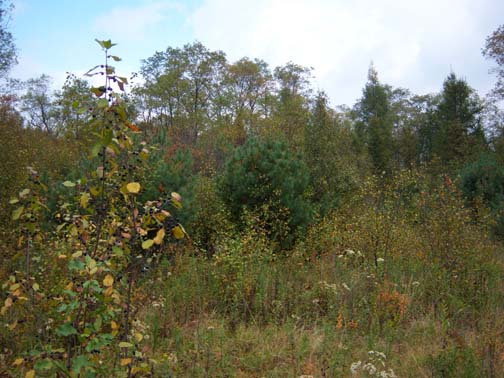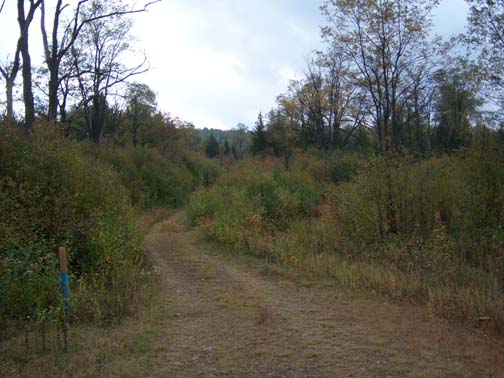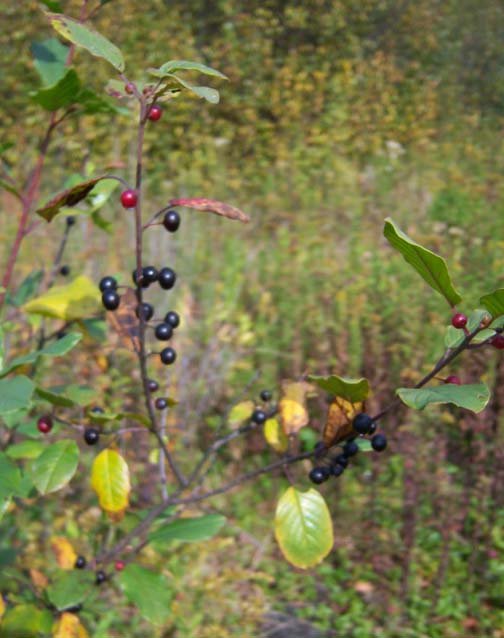|
==============================================================================
TOPIC: European buckthorn (Rhamnus cathartica) infestation in the
Allegheny
National Forest
http://groups.google.com/group/entstrees/browse_thread/thread/826c8f9efe163151?hl=en
==============================================================================
== 1 of 11 ==
Date: Wed, Oct 1 2008 9:31 am
From: Kirk Johnson
Anyone following Allegheny National Forest (ANF) issues will be
hearing a
great deal about European buckthorn (Rhamnus cathartica) trees for
the
foreseeable future. European Buckthorn is a troublesome invasive
exotic
species, it is not native to the ANF, Pennsylvania, or even North
America.
European buckthorn was first noted in the Allegheny National Forest
(ANF)
around 1994 as a small 3-6 acre component of the understory in three
to four
stands in the Pole Road Run and Davidson Run watersheds in Elk
County. Pole
Road Run and Davidson Run are tributaries of Bear Creek, which flows
south
through the proposed Clarion River Wilderness Area and empties into
the
Clarion River.
 |
 |
The attached photos of European buckthorn
were taken during a September 30, 2008 field trip in the ANF
along Forest Road 161A near Pole Road Run, in the
heart of the infested area. |
Buckthorn are small trees reaching 20-25 feet in height and 10
inches in
diameter. Most often they grow in a large shrub form, having a few
to
several stems from the base, with spreading, loosely-branched
crowns. Their
bark is gray to brown with prominent, often elongate,
lighter-colored
lenticels. Cutting a branch exposes a yellow sapwood and a pinkish
to orange
heartwood.
The leaves are 1" - 2 1/2" in size, broadly elliptical,
finely wavy-toothed,
and may be arranged both alternately and oppositely on the same
branch. In
the fall, leaves remain green and attached after most other species
have
lost theirs. The fruits are about 5/16" in diameter, similar in
structure to
a cherry (but containing more than one seed), are very dark colored,
and
numerous. The seeds can remain viable on the forest floor for
several years.
 |
 |
The attached photos of European buckthorn
were taken during a September 30, 2008 field trip in the ANF
along Forest Road 161A near Pole Road Run, in the
heart of the infested area. |
The fruits are eagerly eaten by songbirds, and so the seeds are
spread
widely. It's not necessarily that songbirds prefer buckthorn berries
to
those of native trees and shrubs, it's often the only option
available on
severely infested sites. And since the fruit of buckthorn causes a
severe
laxative effect (hence the species name cathartica), the birds
quickly pass
the seeds in their droppings. When the trees reach maturity they
produce
abundant fruit and within a few years there are commonly thousands
of
seedlings around the base of each mature tree. Also, cut stumps will
sprout
vigorously.
A woodland area severely infested with buckthorn develops into a
very poor
ecosystem. There is a terrible lack of flora and fauna species
diversity,
which is critical for a healthy ecosystem. There is a paucity of
food and
suitable habitat for many wildlife species.
In 2001, casual observations made by employees of the ANF noted that
buckthorn was reaching significant portions of the Pole Run
Road/Davidson
Run region. In 2007, the ANF was given additional funds to inventory
these
infestations and found buckthorn on nearly 3,500 acres -- occupying
an area
1,000 times larger than in 1994:
20% (650 acres) -- heavy infestation
35% (1,150 acres) -- moderate
30% (975 acres) -- light
15% (500 acres) -- trace
Only 50 out of 3,500 acres surveyed failed to find buckthorn.
European buckthorn grows in extremely dense thickets that all but
eliminates
any chance for native vegetation to reproduce on the forest floor.
The
Forest Service has found buckthorn growing in forest conditions they
never
thought possible. Today it can be described literally as a 'plague'
on the
landscape. Its distribution and rate of spread is truly
unprecedented and
unequaled.
Only the very hardest, most compact rock/clay soils on roads and oil
well
pads were found to be unsuitable growing sites. Regardless of the
width of
the road and/or well pad, center of the road and road edges are
found to be
totally infested. This means that old lease roads, pipelines, skid
trails,
and well openings are all avenues for the spread and establishment
of
buckthorn. If any part of these facilities create a break in the
forest
canopy, buckthorn can invade. Even in these 'waste' areas, buckthorn
growth
is rapid and unchecked.
Only the most saturated wetlands, such as beaver ponds and open
seeps have
been found to be unsuitable -- while their edges can be totally
infested.
Although soils that are saturated much of the year are unsuitable,
any small
'hummock,' as little as six inches high, found in these areas that
drain
just a little better were found to support buckthorn.
Please keep your eyes peeled for this aggressive invasive plant when
out and
about in the ANF. If you notice European buckthorn thickets in
portions of
the ANF not mentioned in this email, please report it to the Forest
Service,
they will be grateful for your observation. Let them know what
drainage you
found it growing in, along which Forest Road you observed it
growing, etc.
Bradford Ranger District: (814) 362-4613
Marienville Ranger District: (814) 927-6628
Young buckthorn trees that are in the three- to five-foot range and
smaller
can be pulled out of the ground roots & all relatively easily.
But cutting
them down will only encourage accelerated growth from the cut stump.
Additional information on European buckthorn:
http://www.uwgb.edu/biodiversity/herbarium/invasive_species/rhacat01.htm
http://plants.usda.gov/java/profile?symbol=RHCA3
http://www.nps.gov/plants/ALIEN/fact/rhca1.htm
The attached photos of European buckthorn were taken during a
September 30,
2008 field trip in the ANF along Forest Road 161A near Pole Road
Run, in the
heart of the infested area.
--
Friends of Allegheny Wilderness
220 Center Street
Warren, PA 16365
814-723-0620
info@pawild.org
http://www.pawild.org
A Citizens' Wilderness Proposal for Pennsylvania's Allegheny
National
Forest: http://www.pawild.org/exec_summary.html
== 2 of 11 ==
Date: Wed, Oct 1 2008 10:50 am
From: Elisa Campbell
Kirk,
is there a plan for control? (I realize eradication is probably
impossible at this point)
Elisa
== 3 of 11 ==
Date: Wed, Oct 1 2008 1:08 pm
From: Kirk Johnson
No plan in place right now. Probably some combination of herbicides
and
mechanical treatments. There might be a strategy of simply try to
contain
the core infested area, and stamp out satellite populations where
and when
they crop up.
== 4 of 11 ==
Date: Wed, Oct 1 2008 1:22 pm
From: "Joseph Zorzin"
Re: [ENTS] Re: European buckthorn (Rhamnus cathartica) infestation
in the Allegheny National ForestAllowing native trees to grow over
and shade buckthorn will help control it. It doesn't seem to do well
in heavy shade.
Joe
== 5 of 11 ==
Date: Wed, Oct 1 2008 1:34 pm
From:
Arrgh! Buckthorns!!!
They've been a real big problem here in the western Great Lakes for
20-30 or more years. They are still used as a landscape plant,
although there is finally serious talk about laws to eliminate there
sale here.
They've impeded prairie and wetland restoration and preservation
efforts here and are severely impacting savanna remnants. In
wetlands, they've dropped surface water tables (through
transpiration) by up to 2 feet in some cases, thereby aiding the
introduction of other alien invasives in adjacent wetlands. Local
conservation groups have volunteer-based buckthorn busting events
from time to time.
Lee has mentioned to me in the past that our black cherry is
invasive in Europe and out competes buckthorn there, while the
opposite occurs here.
They are hard on the chainsaws and wood chippers, and stump sprout
aggressively, requiring concentrated Round-up on fresh cut stumps to
finish them off. They are also very difficult to start on fire even
on dried up brush piles, but will burn extremely hot once they are
started.
I've also heard that waxwings actually prefer their berries, to
their own detriment. Apparently the coloring of bohemian/cedar
waxwings changes if they eat non-native berries such as buckthorn,
and the males become less attractive to females, thereby reducing
their success at mating and maintaining their population levels.
Paul Jost
== 6 of 11 ==
Date: Wed, Oct 1 2008 1:46 pm
From:
Buckthorn seems partially shade tolerant here. It's seedling survive
under it's own shade, causing a dense impassable massive expanse of
tangled buckthorn. It will thrive under bur oaks in savannas and
floodplain forests, as well as under oak and hickory on dry glacial
moraines, but seems to struggle only under mature forests with
completely closed canopies. Thinned, managed forests often allow
enough sunlight to reach the ground for them to grow. If grasses can
grow there even if only in small patches, it seems that buckthorn
will grow there, too, eventually shading out and replacing the
grass.
Paul Jost
== 10 of 11 ==
Date: Wed, Oct 1 2008 4:34 pm
From: "Steve Galehouse"
We have a problem here in N Ohio with glossy buckthorn, *Rhamnus
frangula*.
It is tolerant of both shade and poor drainage, and is very common
in
disturbed woods. Have yet to see a European buckthorn in our area,
however.
Steve
== 2 of 4 ==
Date: Thurs, Oct 2 2008 6:08 am
From: Kirk Johnson
We went to some sites during our field trip where they had come in
fairly
aggressively in the understory. I guess all it takes is one little
canopy
opening, one little shaft of light hitting the forest floor and they
will
capitalize on that. One ANF person said he has even found individual
buckthorns growing under hemlock shade!
== 3 of 4 ==
Date: Thurs, Oct 2 2008 6:11 am
From: Kirk Johnson
Interesting facts, thanks!
It would have been difficult to imagine the extent of the problem
here in
the ANF if I had not seen it with my own eyes. I knew buckthorn was
present
here, but wow is that stuff aggressive.
== 4 of 4 ==
Date: Thurs, Oct 2 2008 7:02 am
From: "William Morse"
The only success I have noted requires tenacity and a strong back.
We
have both R. cathartica and R. frangula here in Western NY.
Seedlings
can be pulled. I spray the larger ones with herbicide containing
glycophosphate (Rodeo, Round-up) and try to throw down grass seed or
plantings in the area after everything is dead. This seems to work
good but is labor intensive. I've heard of similar success involving
stacking brush on top of buckthorn thickets to create burn piles but
have not tried it myself. Either way, as with all invasives, areas
not
vegetated or subject to disturbance require frequent monitoring to
slow-down/curb future infestations. Travis
|